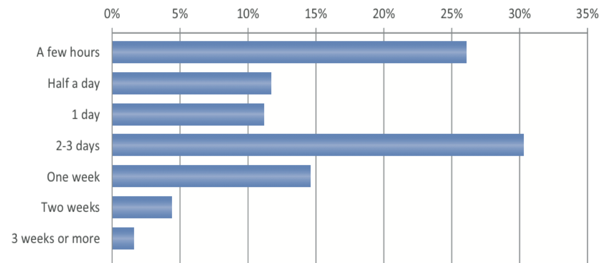
There are many instances throughout various business transactions where a signature is required on a document. While this is to be expected, the way signatures are applied can and does have a significant impact on operating efficiency and costs.
In a recent AIIM report titled "Digital Signatures: Ready for Production," we found that, on average, three days is added to a process just for the purpose of capturing a physical signature (shown below in Figure 1.) Additionally, 21% of the respondents indicated they feel a week or more is added to their processes due to capturing physical signatures. When you think about this process for a physical, wet ink signature, the document is created digitally, printed, signed and scanned back into the system. Then, there is the way the document moves through the organization to the signer and back to the sender. It could be an interoffice mail process or, for external party signatures, the postal system of a courier.
In a recent AIIM report titled "Digital Signatures: Ready for Production," we found that, on average, three days is added to a process just for the purpose of capturing a physical signature (shown below in Figure 1.) Additionally, 21% of the respondents indicated they feel a week or more is added to their processes due to capturing physical signatures. When you think about this process for a physical, wet ink signature, the document is created digitally, printed, signed and scanned back into the system. Then, there is the way the document moves through the organization to the signer and back to the sender. It could be an interoffice mail process or, for external party signatures, the postal system of a courier.
Figure 1: How much time would you say is generally added to a typical formal approval process as a result of physical sign-offs?

Why wait?
While signatures in some form are and will be required as part of business transactions and processes, the question you have to ask is, "Why wait for the physical signature when you can use digital signatures?" Today, digital signatures are an accepted practice for many industries and are now extending beyond the enterprise to suppliers, partners and even customers. Of course, the benefits of this approach are not only reduced time to process but also less chance of lost documents, lowered operational costs and better control over content and process.
What to think about
When considering digital signatures, use, legal and regulatory considerations are certainly areas where vaidation and guidelines must be met. You want to ensure that the approach you take and tools you select will not put you at risk but will, in fact, adhere to your compliance requirements. You will need to know how many documents require signatures, how many per document and the impact digital signatures will have in relation to their associated processes. This is where process mapping becomes a vital part of the assessment and change discussion.
This will, in turn, help in the search for and selection of a solution that is right for your organization. Perhaps you need one that is capable of multiple signatures within a single document. Use of mobile devices for remote workers and travelers might be a requirement, and this would enable sign-off from any location at any time. Does your organization want to be able to sign documents in different formats, like PDF, Word, etc.? These are but a few of the things to consider as you assess the viability and use of digital signatures.
In my view
Digital signature use makes sense for many organizations. While there may still be reluctance by some regarding legal admissibility, security, auditability and the technology itself, I see this as an educational challenge. In many instances, the reason for reluctance is a lack of understanding in relation to technological capabilities and how they align to meet legal and regulatory compliance. Digital signature use will most certainly provide benefit in improved operational efficiencies, lowered costs, auditability and risk management.
Extending digital signature use beyond the enterprise to include suppliers, partners and customers will yield even more benefit and return on investment. The same AIIM study mentioned above on digital signatures found that 68% of respondents indicate payback within 12 months while 37% indicated payback within six months or less. So yes, digital signature is ready for production. The question is, "Are you?"
Digital signature use makes sense for many organizations. While there may still be reluctance by some regarding legal admissibility, security, auditability and the technology itself, I see this as an educational challenge. In many instances, the reason for reluctance is a lack of understanding in relation to technological capabilities and how they align to meet legal and regulatory compliance. Digital signature use will most certainly provide benefit in improved operational efficiencies, lowered costs, auditability and risk management.
Extending digital signature use beyond the enterprise to include suppliers, partners and customers will yield even more benefit and return on investment. The same AIIM study mentioned above on digital signatures found that 68% of respondents indicate payback within 12 months while 37% indicated payback within six months or less. So yes, digital signature is ready for production. The question is, "Are you?"
Bob Larrivee is director of custom research at AIIM and an internationally recognized subject matter expert and thought leader with over 30 years of experience in the fields of information and process management. Follow him on Twitter @BobLarrivee.























